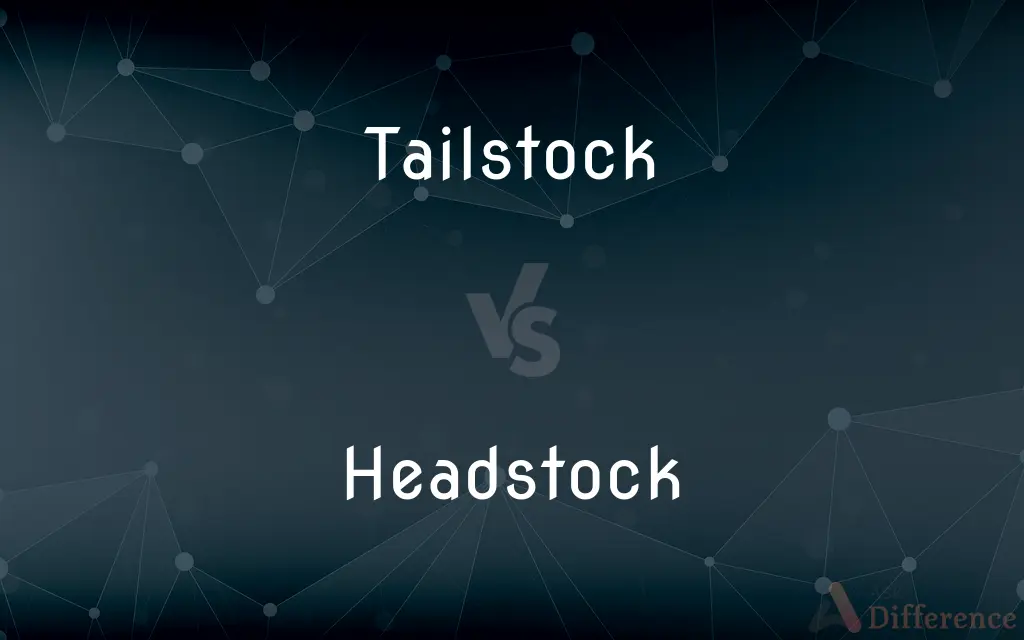Tailstock vs. Headstock — What's the Difference?
By Fiza Rafique & Maham Liaqat — Updated on March 8, 2024
Tailstock supports the end of the workpiece, while headstock holds and rotates it.

Difference Between Tailstock and Headstock
Table of Contents
ADVERTISEMENT
Key Differences
Tailstock is a component found at the opposite end of the lathe bed from the headstock, primarily used to support the end of the workpiece through the center. It can hold tools for drilling, reaming, and threading operations. Whereas the headstock is located at the left end of the lathe bed, serving as the main driving force for the workpiece. It contains the spindle, motor, and gear mechanisms to rotate the workpiece at various speeds.
The tailstock can be adjusted and moved along the lathe bed to accommodate workpieces of different lengths, providing flexibility in the machining process. On the other hand, the headstock is usually fixed in position, establishing the primary rotational speed and power for the machining operation.
While the tailstock supports and aligns with the workpiece, ensuring precision in operations like drilling, the headstock's role is to hold the workpiece securely and impart the necessary rotation for machining.
In terms of functionality, the tailstock is essential for supporting the workpiece against lateral pressures from cutting operations, enhancing the stability and accuracy of the machining process. The headstock, however, is critical for the primary rotation and speed control of the workpiece, making it a key component in determining the lathe's operational capabilities.
The tailstock and headstock serve different purposes, they are complementary components of a lathe, each contributing significantly to the machine's overall functionality and precision in metalworking and woodworking operations.
ADVERTISEMENT
Comparison Chart
Function
Supports the end of the workpiece
Holds and rotates the workpiece
Location
Opposite end of the lathe bed from the headstock
Left end of the lathe bed
Movement
Adjustable along the lathe bed
Usually fixed in position
Operations
Drilling, reaming, threading
Rotating the workpiece at various speeds
Contribution
Enhances stability and accuracy
Primary rotation and speed control
Compare with Definitions
Tailstock
Supports the end of the workpiece.
The tailstock was adjusted to support the long metal rod.
Headstock
Holds and rotates the workpiece.
The headstock rotated the workpiece for the cutting operation.
Tailstock
Works in conjunction with the headstock.
The tailstock and headstock were perfectly aligned for the operation.
Headstock
Key component for machining.
The headstock's functionality is crucial for the lathe's performance.
Tailstock
Can be moved along the lathe bed.
He carefully adjusted the tailstock to accommodate the new workpiece length.
Headstock
Located at the lathe's left end.
The headstock's fixed position provided stability during machining.
Tailstock
Provides stability and precision.
Using the tailstock helped maintain precision during the threading process.
Headstock
Controls the rotational speed.
He adjusted the headstock settings to increase the rotational speed.
Tailstock
Holds tools for operations like drilling.
The drill bit was secured in the tailstock for the drilling operation.
Headstock
Houses the spindle and motor.
The headstock's spindle facilitated various speeds for the operation.
Tailstock
A tailstock, also known as a foot stock, is a device often used as part of an engineering lathe, wood-turning lathe, or used in conjunction with a rotary table on a milling machine. It is usually used to apply support to the longitudinal rotary axis of a workpiece being machined.
Headstock
A headstock or peghead is part of a guitar or similar stringed instruments such as a lute, mandolin, banjo, ukulele and others of the lute lineage. The main function of a headstock is to house the pegs or mechanism that holds the strings at the "head" of the instrument.
Tailstock
A sliding carriage on a lathe that holds the center, the pointed part on which one end of the piece being worked spins.
Headstock
A nonmoving part of a machine or power tool that supports a revolving part, such as the spindle of a lathe.
Tailstock
The part of a lathe that supports the object being worked along its rotatory axis.
Headstock
The part of a stringed instrument adjoined to the end of the neck, where the strings are wound.Also called tuning head.
Tailstock
Support consisting of the movable part of a lathe that slides along the bed in alignment with the headstock and is locked into position to support the free end of the workpiece
Headstock
(mining) A headframe.
Headstock
A part of a machine (such as a lathe or drill) that supports a rotating part
Headstock
A beam that supports a bell.
Headstock
A clamp that restrains a cow by the neck.
Headstock
The part of a lute-type string instrument, such as a guitar, that holds the tuning pegs or tensioning screws of the strings.
Headstock
(rail) A transverse structural member at the extreme end of a rail vehicle's underframe, also used on some bogies.
Headstock
A part (usually separate from the bed or frame) for supporting some of the principal working parts of a machine
Headstock
The stationary support in a machine or power tool that supports and drives a revolving part (as a chuck or the spindle on a lathe)
Common Curiosities
Can the tailstock hold tools?
Yes, the tailstock can hold tools for operations such as drilling and threading.
Is the headstock adjustable like the tailstock?
No, the headstock is usually fixed in position, unlike the tailstock, which is adjustable along the lathe bed.
What components are typically housed within the headstock?
The headstock typically houses the spindle, motor, and gear mechanisms.
Can the tailstock be used for drilling into the workpiece?
Yes, the tailstock can be used for drilling into the workpiece by holding drill bits.
What types of operations can the tailstock support?
The tailstock can support drilling, reaming, and threading operations.
How does the tailstock contribute to machining precision?
The tailstock enhances machining precision by supporting the workpiece against lateral pressures from cutting operations.
How do the tailstock and headstock complement each other?
The tailstock provides support and precision, while the headstock provides the primary rotation and speed control, both essential for effective machining.
Why is the headstock's position fixed?
The headstock's position is fixed to provide a stable base for the primary rotation and speed control of the workpiece.
What role does the spindle play in the headstock?
The spindle plays a crucial role in the headstock by holding the workpiece and allowing it to rotate at various speeds.
Is it possible to machine long workpieces on a lathe?
Yes, machining long workpieces is possible by adjusting the tailstock to support the workpiece's length adequately.
What is the main function of a tailstock?
The main function of a tailstock is to support the end of the workpiece during machining operations.
What is the primary role of the headstock in a lathe?
The primary role of the headstock is to hold and rotate the workpiece at various speeds.
Can the headstock's speed be adjusted?
Yes, the headstock's speed can be adjusted to suit different machining operations.
How does the tailstock enhance the stability of the machining process?
The tailstock enhances the stability by supporting the workpiece against lateral forces, thereby reducing vibrations and inaccuracies.
What makes the headstock critical for a lathe's operation?
The headstock is critical because it provides the necessary rotation and speed control for the workpiece, making it a key component in determining the lathe's operational capabilities.
Share Your Discovery

Previous Comparison
Entity vs. Identity
Next Comparison
Medical vs. ParamedicalAuthor Spotlight
Written by
Fiza RafiqueFiza Rafique is a skilled content writer at AskDifference.com, where she meticulously refines and enhances written pieces. Drawing from her vast editorial expertise, Fiza ensures clarity, accuracy, and precision in every article. Passionate about language, she continually seeks to elevate the quality of content for readers worldwide.
Co-written by
Maham Liaqat















































